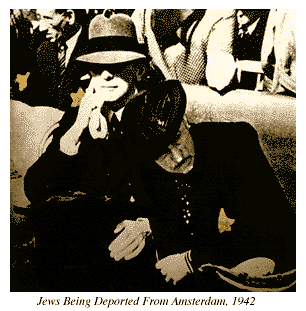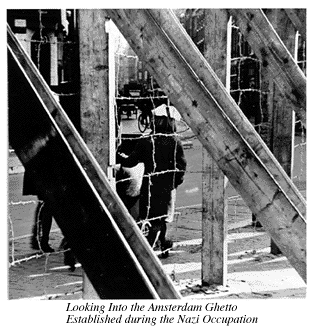TINA STROBOS TELLS HER STORY (Continued)

TINA STROBOS: The Jews should never have registered themselves with the Germans. They were afraid not to. They were afraid that the Germans would find them through synagogue records, which should have been immediately destroyed. There were, of course, signs posted all over the city saying that if you didn't register, terrible things would happen, and if you did, they wouldn't bother you. In retrospect, who would believe that?
All my Jewish friends registered. There was this very good friend of my mother's, a journalist. He was not an observant Jew, and he didn't happen to look Jewish. He wore the Jewish star but he would also go in the streetcar, which was one of the things forbidden to Jews. He just put his coat on over his star and thought that he was safe. Well, he was caught on the streetcar. They were constantly trying to catch people. If you didn't look Jewish, and you didn't register, and you didn't wear a star, nothing happened to you. But do you know, I don't know anybody who did that? Not one.
Before the Nazi occupation there were no anti-Semitic regulations in Amsterdam that I know of; Jews lived all over the city. But, there was an
old Jewish quarter,
which happened to be one of the nicest neighborhoods in Amsterdam, not at all poverty-stricken. It was a lower middle-class merchants' neighborhood, full of seventeenth century houses situated on beautiful little canals. They had a wonderful market there each Sunday, and everybody I knew always went to it. Somewhat like New York's Lower East Side, there were stalls where you could buy clothes, and wonderful food--pickles, Jewish delicatessens. It was a great place to buy fresh bagels and bread on Sunday. In fact, it was the only place, since the bakers' union required that all the other city bakeries close on Sunday. But the Jewish bakers observed their sabbath on Saturday, so they were allowed to be open. We all went there for a good time, and for the bread.
In '41 the Germans closed off the Jewish quarter and forced into it all the Jews living in other parts of the city. They put up barbed wire all around, but they left the main thoroughfares open, so there was still lively communication and trade. We could
go in and out, and the Jewish people could go in and out, but that didn't hinder the Gestapo raiding procedures at all, because everyone had to be home by the 8 P.M. curfew.
 They used the Jewish theater, not far from where Rembrandt lived, to hold people they rounded up before deporting them to the camps. Once you were in there it was very hard to get out--but it happened. In the beginning, you could still get out with the right kind of passport, or if you knew how to sew German uniforms, or if you were important in the diamond trade, or had some other important job. If you belonged to the Jewish Council, you were excused. But in the end, they went too.
They used the Jewish theater, not far from where Rembrandt lived, to hold people they rounded up before deporting them to the camps. Once you were in there it was very hard to get out--but it happened. In the beginning, you could still get out with the right kind of passport, or if you knew how to sew German uniforms, or if you were important in the diamond trade, or had some other important job. If you belonged to the Jewish Council, you were excused. But in the end, they went too.
 They used the Jewish theater, not far from where Rembrandt lived, to hold people they rounded up before deporting them to the camps. Once you were in there it was very hard to get out--but it happened. In the beginning, you could still get out with the right kind of passport, or if you knew how to sew German uniforms, or if you were important in the diamond trade, or had some other important job. If you belonged to the Jewish Council, you were excused. But in the end, they went too.
They used the Jewish theater, not far from where Rembrandt lived, to hold people they rounded up before deporting them to the camps. Once you were in there it was very hard to get out--but it happened. In the beginning, you could still get out with the right kind of passport, or if you knew how to sew German uniforms, or if you were important in the diamond trade, or had some other important job. If you belonged to the Jewish Council, you were excused. But in the end, they went too.
